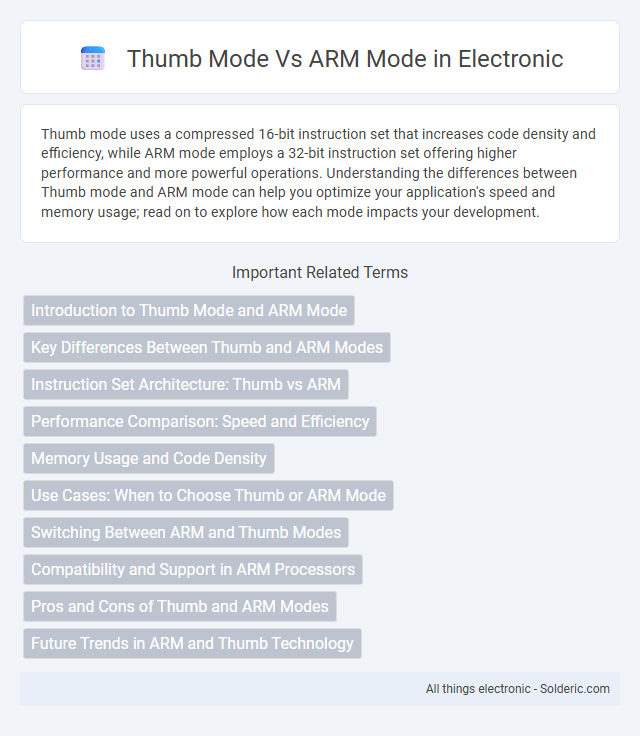Thumb mode uses a compressed 16-bit instruction set that increases code density and efficiency, while ARM mode employs a 32-bit instruction set offering higher performance and more powerful operations. Understanding the differences between Thumb mode and ARM mode can help you optimize your application's speed and memory usage; read on to explore how each mode impacts your development.
Comparison Table
| Feature | Thumb Mode | ARM Mode |
|---|---|---|
| Instruction Set | 16-bit compressed instructions | 32-bit full-length instructions |
| Code Density | Higher code density (smaller code size) | Lower code density (larger code size) |
| Execution Speed | Generally slower due to instruction decoding | Faster due to full 32-bit instructions |
| Use Case | Embedded systems, memory-constrained devices | Performance-critical applications |
| Register Access | Limited register set in instructions | Full register set available |
| Power Consumption | Lower power usage due to smaller code footprint | Higher power consumption due to heavier instructions |
| Compatibility | Requires switching between modes for access to full features | Supports all ARM architecture features |
Introduction to Thumb Mode and ARM Mode
Thumb mode uses a compressed 16-bit instruction set designed to improve code density and reduce memory usage, while ARM mode employs a full 32-bit instruction set offering richer instruction options and higher performance. Your choice between Thumb and ARM modes influences the balance between efficiency and speed, with Thumb ideal for memory-constrained applications and ARM suited for compute-intensive tasks. Understanding these modes enables optimized software development on ARM-based processors.
Key Differences Between Thumb and ARM Modes
Thumb mode uses 16-bit instructions offering better code density, while ARM mode employs 32-bit instructions for higher performance and more complex operations. Thumb mode is ideal for memory-constrained environments, delivering reduced code size with some trade-off in execution speed. Your choice between Thumb and ARM modes depends on whether you prioritize compact code or maximum processing power.
Instruction Set Architecture: Thumb vs ARM
Thumb mode uses a 16-bit compressed instruction set designed to improve code density and reduce memory usage, while ARM mode operates with a 32-bit instruction set that executes more complex instructions for higher performance. Thumb instructions generally require fewer bits, enabling faster instruction fetches and improved efficiency in memory-constrained environments, whereas ARM instructions provide greater functionality and support for more addressing modes. Modern ARM processors support both modes and can switch dynamically, optimizing performance and code size based on application requirements.
Performance Comparison: Speed and Efficiency
ARM mode delivers higher performance with 32-bit instructions that enable faster processing and greater computational power for complex tasks. Thumb mode uses 16-bit instructions that reduce code size and improve memory efficiency, but it may slightly decrease execution speed compared to ARM mode. For your application, choosing ARM mode enhances raw speed, while Thumb mode favors efficiency and smaller code footprint.
Memory Usage and Code Density
Thumb mode utilizes 16-bit instruction sets, significantly improving code density and reducing memory usage compared to ARM mode's 32-bit instructions. This higher code density results in smaller binary sizes, making Thumb mode ideal for memory-constrained embedded systems. ARM mode, while offering more powerful instructions and better performance, typically requires more memory due to larger instruction sizes.
Use Cases: When to Choose Thumb or ARM Mode
Thumb mode is ideal for applications requiring reduced code size and improved memory efficiency, such as embedded systems and handheld devices where limited storage is a constraint. ARM mode is better suited for performance-critical tasks needing faster execution and complex operations, common in high-performance computing and real-time processing. Choosing Thumb mode enhances code density, while ARM mode prioritizes maximum processing power and speed.
Switching Between ARM and Thumb Modes
Switching between ARM and Thumb modes is achieved through the T-bit in the Program Status Register (PSR), which determines the current instruction set being executed. When you set the T-bit to 0, the processor operates in ARM mode, executing 32-bit instructions, whereas setting the T-bit to 1 switches to Thumb mode, running compressed 16-bit instructions for improved code density. Your software can change modes using a BX (Branch and Exchange) instruction that updates the T-bit based on the target address's least significant bit.
Compatibility and Support in ARM Processors
Thumb mode provides enhanced code density by using 16-bit instructions, making it ideal for memory-constrained environments, while ARM mode utilizes 32-bit instructions for higher performance and full feature support. Most ARM processors support both modes, allowing developers to switch between them to balance performance and memory usage effectively. The ARM architecture ensures backward compatibility by enabling Thumb mode to execute a subset of ARM instructions, maintaining broad software support across diverse ARM-based devices.
Pros and Cons of Thumb and ARM Modes
Thumb mode offers improved code density with 16-bit instructions, making it ideal for memory-constrained environments, but it may result in slightly reduced performance compared to ARM mode's full 32-bit instructions. ARM mode provides higher execution speed and better support for complex operations, benefiting applications requiring maximum processing power, though it consumes more memory due to larger instruction sizes. Your choice between Thumb and ARM modes depends on whether you prioritize code size efficiency or execution performance for your specific embedded system needs.
Future Trends in ARM and Thumb Technology
Future trends in ARM and Thumb technology emphasize enhanced energy efficiency and improved performance through advanced instruction set architectures like ARMv9. Thumb mode continues evolving with Thumb-2, enabling higher code density and faster execution suitable for resource-constrained devices. You can expect ARM architectures to integrate more AI and security features, leveraging the dual-mode capabilities for optimized application development across diverse platforms.
Thumb mode vs ARM mode Infographic

 solderic.com
solderic.com